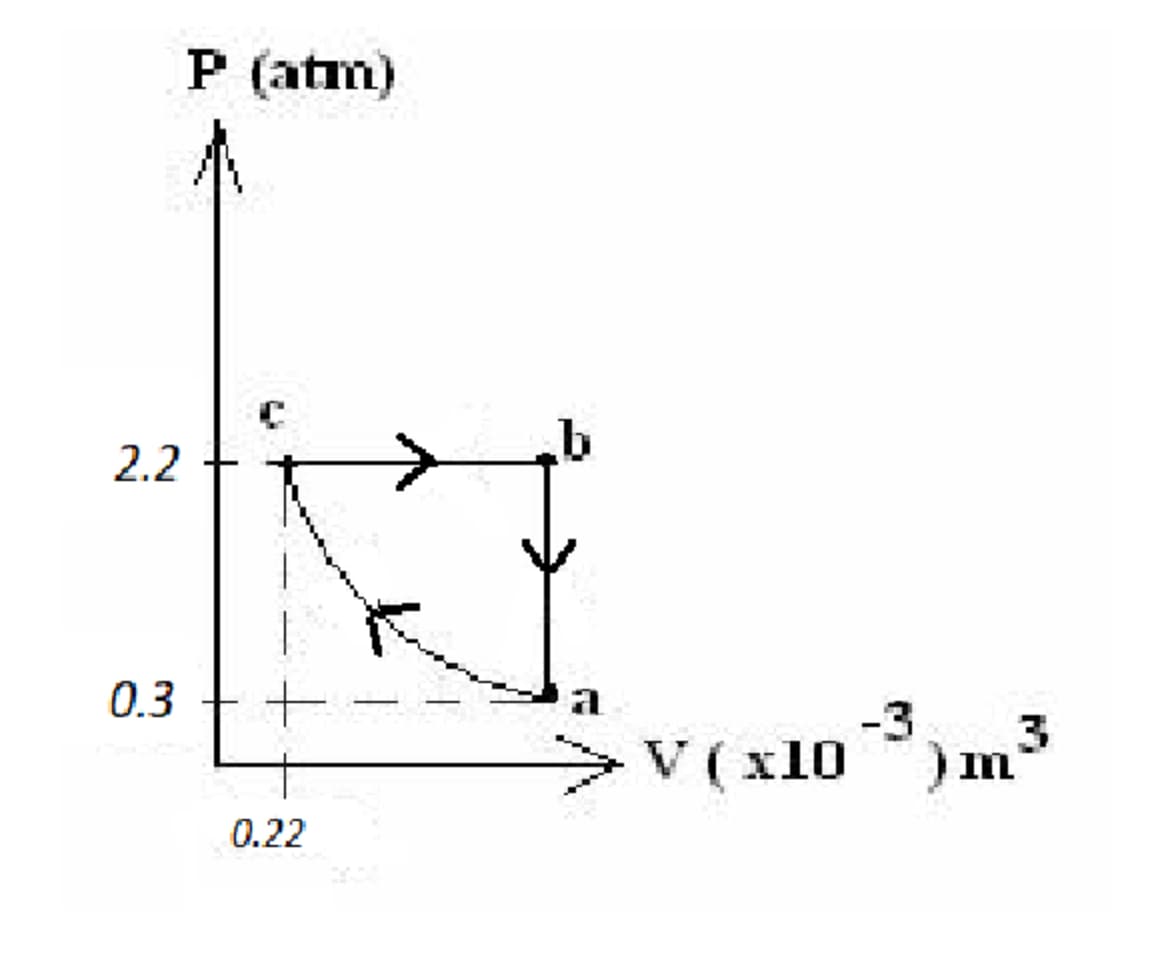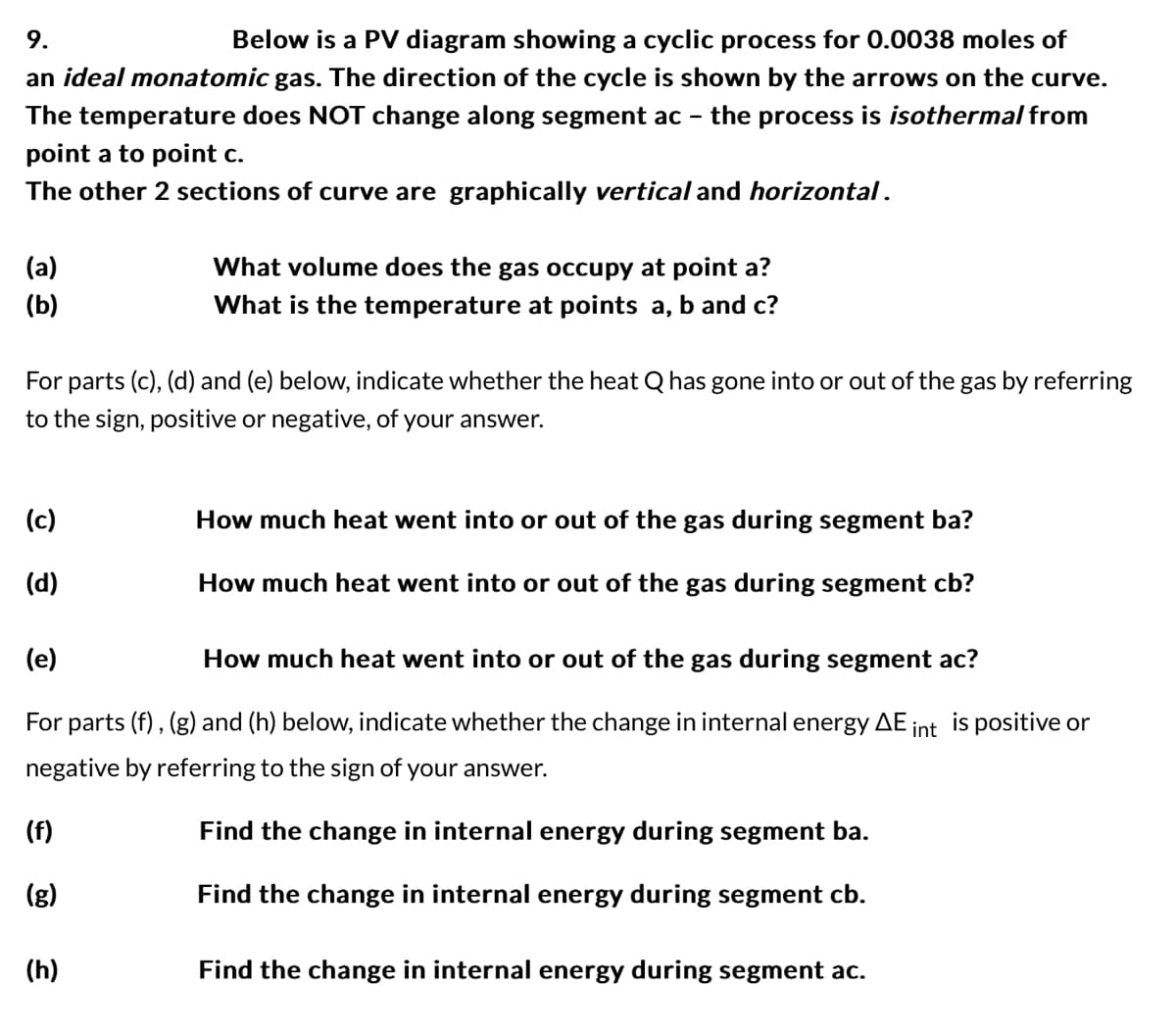9. Below is a PV diagram showing a cyclic process for 0.0038 moles of an ideal monatomic gas. The direction of the cycle is shown by the arrows on the curve. The temperature does NOT change along segment ac - the process is isothermal from point a to point c. The other 2 sections of curve are graphically vertical and horizontal. (a) (b) For parts (c), (d) and (e) below, indicate whether the heat Q has gone into or out of the gas by referring to the sign, positive or negative, of your answer. (c) (d) What volume does the gas occupy at point a? What is the temperature at points a, b and c? (f) (g) (h) How much heat went into or out of the gas during segment ba? How much heat went into or out of the gas during segment cb? (e) For parts (f), (g) and (h) below, indicate whether the change in internal energy AE int negative by referring to the sign of your answer. Find the change in internal energy during segment ba. Find the change in internal energy during segment cb. Find the change in internal energy during segment ac. How much heat went into or out of the gas during segment ac? is positive or
9. Below is a PV diagram showing a cyclic process for 0.0038 moles of an ideal monatomic gas. The direction of the cycle is shown by the arrows on the curve. The temperature does NOT change along segment ac - the process is isothermal from point a to point c. The other 2 sections of curve are graphically vertical and horizontal. (a) (b) For parts (c), (d) and (e) below, indicate whether the heat Q has gone into or out of the gas by referring to the sign, positive or negative, of your answer. (c) (d) What volume does the gas occupy at point a? What is the temperature at points a, b and c? (f) (g) (h) How much heat went into or out of the gas during segment ba? How much heat went into or out of the gas during segment cb? (e) For parts (f), (g) and (h) below, indicate whether the change in internal energy AE int negative by referring to the sign of your answer. Find the change in internal energy during segment ba. Find the change in internal energy during segment cb. Find the change in internal energy during segment ac. How much heat went into or out of the gas during segment ac? is positive or
Physics for Scientists and Engineers, Technology Update (No access codes included)
9th Edition
ISBN:9781305116399
Author:Raymond A. Serway, John W. Jewett
Publisher:Raymond A. Serway, John W. Jewett
Chapter22: Heat Engines, Entropy, And The Second Law Of Thermodynamics
Section: Chapter Questions
Problem 22.32P: At point A in a Carnot cycle, 2.34 mol of a monatomic ideal gas has a pressure of 1 4000 kPa, a...
Related questions
Question
Please please answer everything please I'm begging please answer everything please please

Transcribed Image Text:2.2
0.3
P (atm)
0.22
a
-3
>V (x10³)m³

Transcribed Image Text:9.
Below is a PV diagram showing a cyclic process for 0.0038 moles of
an ideal monatomic gas. The direction of the cycle is shown by the arrows on the curve.
The temperature does NOT change along segment ac - the process is isothermal from
point a to point c.
The other 2 sections of curve are graphically vertical and horizontal.
(a)
(b)
For parts (c), (d) and (e) below, indicate whether the heat Q has gone into or out of the gas by referring
to the sign, positive or negative, of your answer.
(c)
(d)
What volume does the gas occupy at point a?
What is the temperature at points a, b and c?
(f)
(g)
(e)
How much heat went into or out of the gas during segment ac?
int
For parts (f), (g) and (h) below, indicate whether the change in internal energy AE;
negative by referring to the sign of your answer.
Find the change in internal energy during segment ba.
Find the change in internal energy during segment cb.
(h)
How much heat went into or out of the gas during segment ba?
How much heat went into or out of the gas during segment cb?
Find the change in internal energy during segment ac.
is positive or
Expert Solution
This question has been solved!
Explore an expertly crafted, step-by-step solution for a thorough understanding of key concepts.
This is a popular solution!
Step 1: Determine the given data:
VIEWStep 2: a) Calculate the volume at a:
VIEWStep 3: b) Calculate the temperatures:
VIEWStep 4: c) Heat in or out in ba:
VIEWStep 5: d) Heat in or out in cb:
VIEWStep 6: e) Heat in or out in ac:
VIEWStep 7: f) Calculate the change in internal energy in ba:
VIEWStep 8: g) Calculate the change in internal energy in cb:
VIEWStep 9: g) Calculate the change in internal energy in ac:
VIEWSolution
VIEWTrending now
This is a popular solution!
Step by step
Solved in 10 steps with 11 images

Knowledge Booster
Learn more about
Need a deep-dive on the concept behind this application? Look no further. Learn more about this topic, physics and related others by exploring similar questions and additional content below.Recommended textbooks for you

Physics for Scientists and Engineers, Technology …
Physics
ISBN:
9781305116399
Author:
Raymond A. Serway, John W. Jewett
Publisher:
Cengage Learning

Principles of Physics: A Calculus-Based Text
Physics
ISBN:
9781133104261
Author:
Raymond A. Serway, John W. Jewett
Publisher:
Cengage Learning

Physics for Scientists and Engineers with Modern …
Physics
ISBN:
9781337553292
Author:
Raymond A. Serway, John W. Jewett
Publisher:
Cengage Learning

Physics for Scientists and Engineers, Technology …
Physics
ISBN:
9781305116399
Author:
Raymond A. Serway, John W. Jewett
Publisher:
Cengage Learning

Principles of Physics: A Calculus-Based Text
Physics
ISBN:
9781133104261
Author:
Raymond A. Serway, John W. Jewett
Publisher:
Cengage Learning

Physics for Scientists and Engineers with Modern …
Physics
ISBN:
9781337553292
Author:
Raymond A. Serway, John W. Jewett
Publisher:
Cengage Learning

Physics for Scientists and Engineers
Physics
ISBN:
9781337553278
Author:
Raymond A. Serway, John W. Jewett
Publisher:
Cengage Learning


Physics for Scientists and Engineers: Foundations…
Physics
ISBN:
9781133939146
Author:
Katz, Debora M.
Publisher:
Cengage Learning